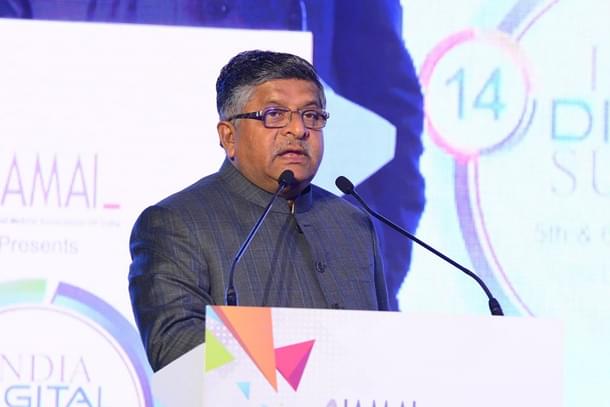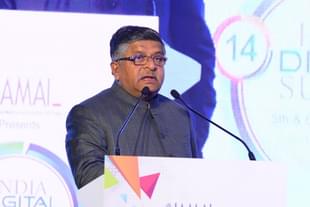Economy
“These Schemes Will Provide Employment Opportunities To More Than 10 Lakh People”: Ravi Shankar Prasad On Modi Government’s Electronics Push
Arihant Pawariya
Jul 02, 2020, 03:02 PM | Updated 02:54 PM IST
Save & read from anywhere!
Bookmark stories for easy access on any device or the Swarajya app.


India was producing $29 billion worth of electronics in 2014, and imports stood at $38 billion. In 2018-19, production jumped to $70 billion and imports increased to $57 billion.
Thanks to this significant addition in production, directly or indirectly, around two million jobs were created.
Bolstered by this success, the Narendra Modi government now wants to build on it.
It has unveiled three new schemes: production linked incentive (PLI), scheme for production of electronic components and semiconductors (SPECS) and electronics manufacturing clusters (EMC 2.0).
The total value of monetary incentive (in form of capex subsidies) announced stands at Rs 50,000 crore with the goal of increasing production to values of $106 billion (from $70 billion in 2018-19). The target for exports is $77 billion.
Swarajya spoke to Union Minister for Electronics and Information Technology, Ravi Shankar Prasad, on how these will help India become a global leader in electronics manufacturing.
Edited excerpts:
You just launched three new schemes to incentivise companies to increase electronics manufacturing in India — PLI, SPECS and EMC 2.0. Usually, there is lot of scepticism in the industry regarding such initiatives of the government, especially on the ‘Make in India’ front. They can’t be faulted because most initiatives have failed in the past. What makes you confident about success of these new schemes?
The government attaches high priority to electronics hardware manufacturing as it is one of the important pillars of both “Make in India” and “Digital India” programmes of the government of India.
The vision of National Policy on Electronics 2019 (NPE 2019) notified on 25 February 2019 is to position India as a global hub for electronics system design and manufacturing (ESDM) by encouraging and driving capabilities in the country for developing core components, including chipsets, and creating an enabling environment for the industry to compete globally.
As a result of several initiatives undertaken by government for the promotion of electronics hardware manufacturing in the country, the domestic production of electronic goods has increased substantially from Rs 190,366 crore in 2014-15 to an estimated Rs 458,006 crore in 2018-19, at a compound annual growth rate (CAGR) of about 25 per cent.
India’s share in global electronics manufacturing has grown from 1.3 per cent in 2012 to 3 per cent in 2018.
India’s production has surpassed its electronics imports in the last five years (production grew at CAGR 25 per cent as against imports CAGR of 11 per cent). India has emerged as the second-largest manufacturer of mobile handsets in the world in volume terms.
As per industry estimates, the production of mobile handsets has grown from Rs 18,900 crore in 2014-15 and is estimated to be around Rs 214,000 crore in 2019-20 (in 2018-19, it was Rs 170,000 crore).
To attract and incentivise large investments in the electronics value chain and promote exports, following three schemes have been notified under the aegis of NPE 2019:
(i) Production-linked incentive scheme (PLI) for large scale electronics manufacturing shall extend an incentive of 4 per cent to 6 per cent to eligible companies on incremental sales (over base year) involved in mobile phone manufacturing and manufacturing of specified electronic components, including assembly, testing, marking and packaging (ATMP) units.
(ii) Scheme for promotion of manufacturing of electronic components and semiconductors (SPECS) will provide financial incentive of 25 per cent on capital expenditure for the identified list of electronic goods that comprise downstream value chain of electronic products, ie, electronic components, semiconductor/display fabrication units, ATMP units, specialised sub-assemblies and capital goods for manufacture of aforesaid goods.
(iii) Modified electronics manufacturing clusters (EMC 2.0) scheme shall provide support for creation of world-class infrastructure along with common facilities and amenities, including ready built factory (RBF) sheds/plug and play facilities for attracting major global electronics manufacturers along with their supply chain to set up units in the country. The scheme shall provide financial assistance for setting up of both EMC projects and common facility centres (CFCs) across the country.
Under the PLI scheme, there are not only five-year investment and sales targets that the eligible companies will have to meet but there are annual targets as well. Don’t you think setting a ceiling (which runs into thousands of crores for sales) can be an impediment for companies to commit to making in India under this scheme?
The mobile phone market is dominated by five to six companies globally which account for about 80 per cent of the world’s market share. These companies are able to exploit large economies of scale to compete in global markets. It is imperative that these companies expand their operations in India and make it a major destination for manufacturing of mobile phones.
The PLI scheme shall extend an incentive of 4 per cent to 6 per cent on incremental sales (over base year) of goods manufactured in India and covered under target segments, to eligible companies, for a period of five years subsequent to the base year as defined. Under the scheme, thresholds of incremental investment and incremental sales of manufactured goods need to be achieved to be eligible under PLI scheme.
With PLI scheme, it is expected that some of these companies will be attracted by the incentives and make significant investments to carry out large scale manufacturing in the country.
Rs 41,000 crore outlay for PLI is really impressive but for the other two schemes — SPECS and EMC 2.0, it’s comparatively really low (Rs 3,000 crore+). It takes upwards of Rs 10,000 crore to set up a full-fledged fab (semiconductor fabrication plant). Under SPECS, that means reimbursement of around Rs 2,500 crore (25 per cent of capex). And since there is no upper limit for reimbursement under SPECS, what if a lot of companies make a beeline to invest large sums? In that case, outlay doesn’t seem to be sufficient.
The outlay for the SPECS and EMC2.0 has been estimated on the basis of the detailed consultation with the stakeholders. The demand projection and the investment required to meet the demand was factored in while finalising the outlay for these schemes.
It is right that it takes upwards of Rs 10,000 crore to set up full-fledged FAB. Ministry of Electronics and Information Technology (MeitY) is also working on separate policy towards setting up semiconductor FAB in the country.
Under SPECS, the government has put a cap of 20 per cent for reimbursement of refurbished items. This is surprising given that in semiconductor industries, refurbished items are not waste and they can potentially lower the cost of production by a third. Shouldn’t that limit of 20 per cent be raised, at least for companies which will invest huge amounts?
Under the SPECS scheme, the total value of refurbished plant, machinery and equipment (including for associated utilities and R&D), whether imported or domestically procured, not exceeding 20 per cent of the total eligible plant, machinery and equipment (including for associated utilities and R&D), will be considered for calculation of incentive.
This was arrived at based on the inter-ministerial consultation during the drafting of the scheme. It was highlighted during those consultations that with higher percentage of refurbished/second-hand/used, industry may buy such machinery at inflated cost which not only allows them benefit under schemes but also higher depreciation under the Income Tax Act 1961.
Discussions around these schemes have been limited to companies, investments, etc. Now, how would you explain the usefulness of these schemes to a common man, let’s say a migrant who sees his future in jeopardy today, or to students who are entering the job market?
Apart from boosting domestic manufacturing and export of electronic goods from the country, these schemes will provide employment opportunities to more than 10 lakh people including common man and students who are entering the job market.
One of the major impediments to electronics manufacturing in India is lack of skilled workforce amidst rapidly changing world of technology. Are there plans to rope in HRD and Skills Ministry to solve those issues?
Electronics manufacturing requires skilled workforce. MeitY has following two schemes for skill development in the ESDM sector:
(i) “Scheme for financial assistance to select states/ UTs for skill development in ESDM sector”.
(ii) “Skill development in ESDM for Digital India”.
The aforesaid schemes have a cumulative target of skilling 418,000 candidates at a cumulative outlay of Rs 524.71 crore out of which an amount of Rs 454.85 crore is the grants-in-aid. These schemes are being implemented in all states/UTs across the country. As on date, under these two schemes, a total of 3.76 lakh candidates have been enrolled and trained in various states/UTs, out of which around 2.21 lakh candidates have been certified.
The unprecedented migrant exodus from big metros during the Covid-19 crisis has again highlighted the grave issue of development gaps between the Eastern India and West/South India. Electronics manufacturing is a great opportunity to create 1.5-2 million jobs in a very short period in states like UP, Bihar, West Bengal, etc. These states also have good water availability which the Fab industry needs. Power situation has improved immensely too in recent times. Do you see an interest from some of these states? States’ cooperation will matter a lot in getting companies to invest as they will have to facilitate land and infra for units.
Yes, there is an immense interest from the states to set up electronics industry in general and in the new schemes launched by MeitY.
In addition to MeitY’s schemes the states are also offering various other incentives to land the projects in their respective states. Western UP (part of NCR) has already emerged as a prominent cluster in India for electronics manufacturing with several multinationals and domestic companies making it their manufacturing base.
Several of these states have already come out with their own electronics policies or electronics sector features prominently in their industrial and IT policies.
MeitY is working closely with the state governments to help them attract investment in electronics manufacturing. The states are providing full support in attracting electronics manufacturing companies (both domestic and international) to India.
As mentioned above, the new schemes (PLI, SPECS and EMC 2.0) will provide employment opportunities to more than 10 lakh people including common man and students who are entering the job market.
Lastly, what benefits do you see India accruing in short and long term if you succeed in achieving getting big investments via these schemes?
Overall impact of these schemes:
- The overall incremental manufacturing in electronics sector on account of these schemes alone is expected to be Rs 8 lakh crore over the next five years.
- These schemes will result in exports of electronic goods (mobile as well as components and other segments) in excess of Rs 5.8 lakh crore over the next five years.
- These schemes will provide employment to more than 10 lakh people in electronics manufacturing sector.
Arihant Pawariya is Senior Editor, Swarajya.





